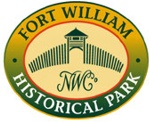| Revision as of 13:41, 21 February 2008 editDoug Coldwell (talk | contribs)Extended confirmed users, Pending changes reviewers70,556 edits →External links: added Fort William Historical Park artifact pictures + some formatting← Previous edit | Revision as of 17:35, 14 July 2008 edit undoBearcat (talk | contribs)Autopatrolled, Administrators1,568,080 editsNo edit summaryNext edit → | ||
| Line 32: | Line 32: | ||
| ] | ] | ||
| ] | ] | ||
| ] | ] | ||
| ] | ] | ||
| ] | ] | ||
Revision as of 17:35, 14 July 2008




Fort William Historical Park (formerly known as Old Fort William) is a Canadian historical site located in Thunder Bay, Ontario, that contains a reconstruction of the Fort William fur trade post as it existed in 1815. It officially opened on July 3, 1973.
The original trading post was located at Grand Portage, Minnesota, however the British / Canadian fur traders had been forced to abandon Grand Portage as their centre of operations when that area was ceded to the United States after the American Revolution, and to avoid American taxes the trading post was moved to what became Fort William on the Canadian side of the border..
Fort William Historical Park is known as a living history site, where reconstructed buildings and costumed historical interpreters recreate Fort William of the year 1815. At that time Fort William was not primarily a settlement, but a central transport depot within the now-defunct North West Company's network of fur trade outposts. Due to its central role, Fort William was much larger and more multifaceted than the average fur trade post. Reflecting this, Fort William Historical Park contains 42 reconstructed buildings, a reconstructed Ojibwa village, and a small farm. Historical interpreters represent the many roles and cultures involved in the fur trade, including Scottish fur traders, French Canadian voyageurs and workers, and native hunters. The native people in the Fort William area are predominantly Ojibwa and are represented accordingly among the interpreters.
Fort William Historical Park may also be noted for its working community of skilled tradesmen, including a blacksmith, tinsmith, carpenter, cooper, and birch bark canoe builder who all work according to traditional 19th-century methods. Many of their crafts are not widely practiced elsewhere, and Fort William's canoe builder has built birch bark canoes for other Canadian cultural sites, including the Canadian Museum of Civilization.
Each summer Fort William Historical Park hosts the Great Rendezvous, a recreation of the annual meeting of company fur traders that took place at this central location. Participants from all over Canada and the United States register to camp for the weekend at Fort William Historical Park and take part in this historical reenactment.
Fort William Historical Park is located on the banks of the Kaministiquia River at Point de Meuron. This point is a few kilometres upstream from the original fort's site, which has been built over as part of the city of Thunder Bay, but holds historical significance of its own. Point de Meuron derives its name from the mercenary De Meuron soldiers who used the point as a base camp when attacking Fort William on behalf of the North West Company's rival, the Hudson's Bay Company, in 1816.
Fort William Historical Park is a historical site operated by the Ontario provincial government. It has been noted as one of Canada's top ten tourist attractions and as one of Canada's top living history sites.
Location
The actual location of Fort William Historical Park is not well documented on the official website. Purportedly, there are numerous signs in the area directing visitors to the park. For those trying to pre-plan their route to the park, its precise location in Thunder Bay, Ontario is at the South end of King Road. King Road runs off of Broadway Avenue between Highways 61 and 130.
Its LAT/LONs are 48.345483 North, -89.357085 East.
References
- Morrison, Jean F. Superior rendez-vous place : Fort William in the Canadian fur trade. Toronto : Natural Heritage Books, 2007. 1st ed. appeared in 2001. The most authoritative book on Fort William
- "A Golden Gateway of the Great Northwest - History of Thunder Bay" Joseph M. Mauro,Lehto Printers Ltd. Thunder Bay, Ontario - 1981 pgs 21-23
External links
- Fort William Historical Park artifact pictures
- Fort William Historical Park The Official Site
- Ontario Hwy 11 Homepage: Old Fort William